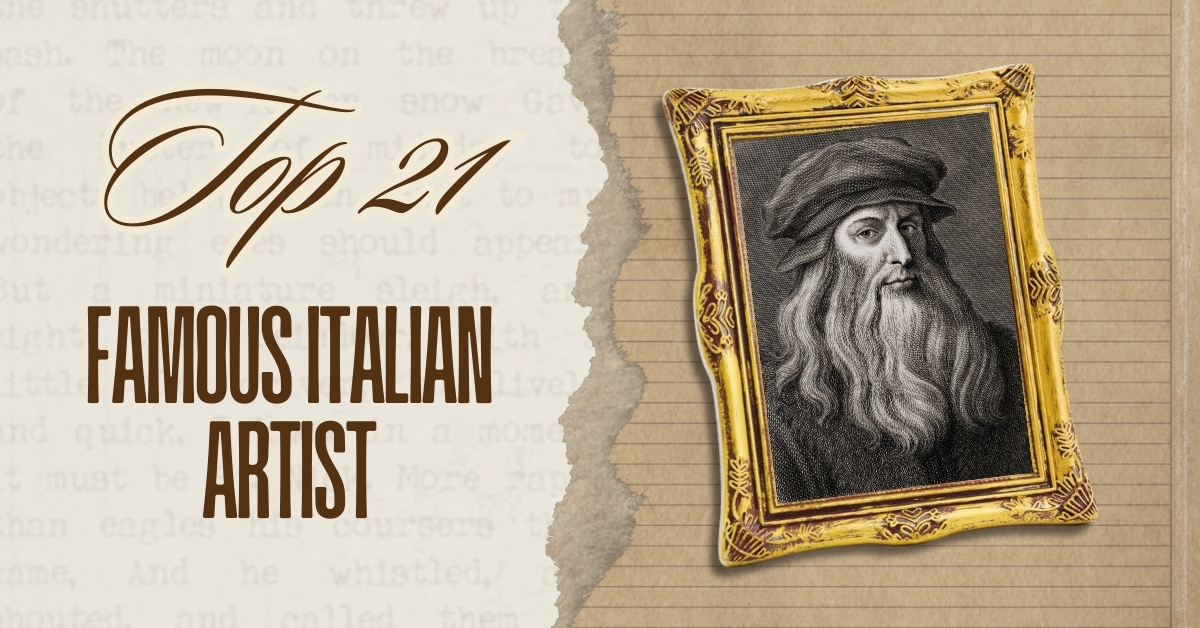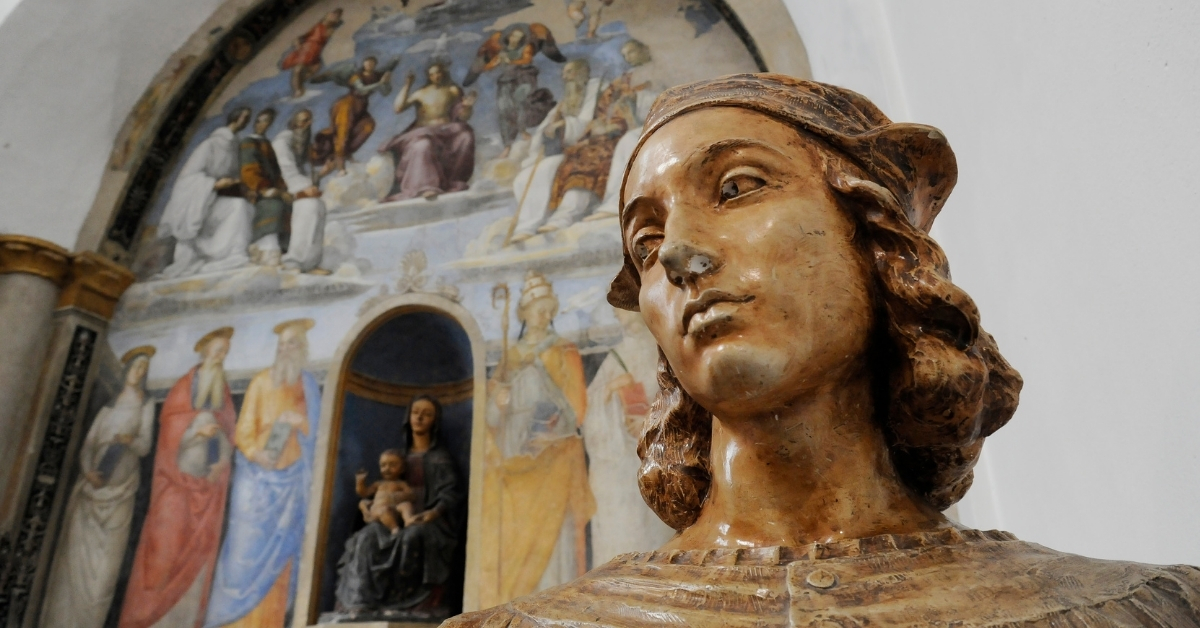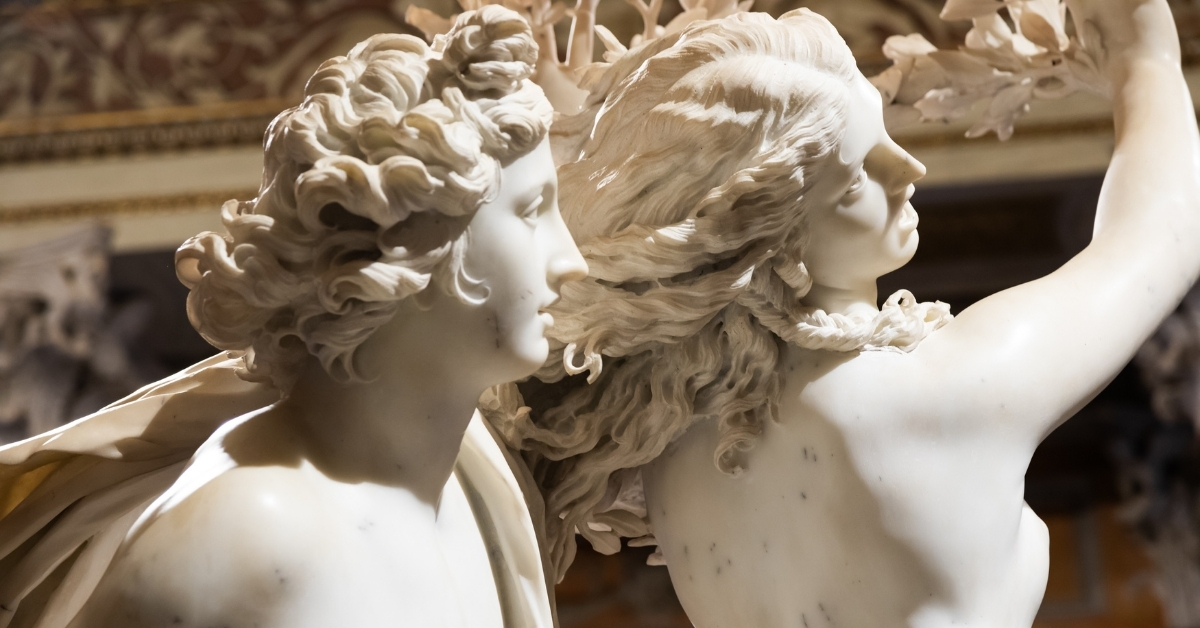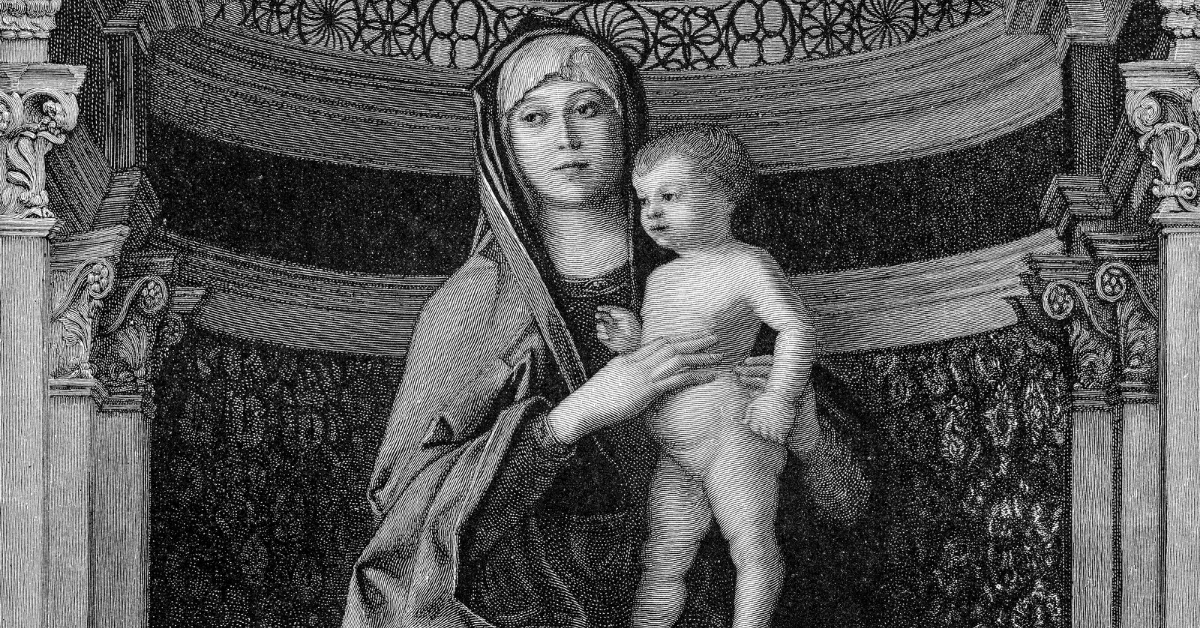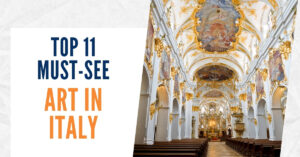Italy, a country that is as renowned for its rich history as it is for its art, has been the birthplace of countless artists who have left an indelible mark on the world. The Italian Renaissance, a period of great cultural change and achievement, spawned a galaxy of artists whose works continue to inspire awe and admiration.
This blog post shines a spotlight on the top 21 famous Italian artists, whose contributions have not only shaped the course of art history but have also defined the very essence of human creativity. From the masterful strokes of Leonardo da Vinci to the prophetic visions of Michelangelo, join us as we explore the lives, works, and enduring legacy of Italy’s most illustrious sons and daughters of art.
1. Leonardo da Vinci
Leonardo da Vinci (1452-1519), a polymath of the High Renaissance. He was acclaimed for his profound contributions to art, science, and engineering. Known as the epitome of the “Renaissance Man,” his genius traversed various fields, but it’s his artworks — the Mona Lisa and The Last Supper — that have etched his name in eternity.
Leonardo’s inquisitive mind and detailed anatomical studies have influenced both art and science, embodying the marriage of artistic skill and scientific inquiry.
2. Michelangelo
Michelangelo Buonarroti (1475-1564), a towering figure of the Italian Renaissance, is best known for his masterpieces in sculpture, painting, and architecture. His iconic works, such as the Statue of David, the Sistine Chapel ceiling, and The Last Judgment, showcase his unparalleled skill and profound understanding of the human form.
Michelangelo’s work not only depicts the beauty of the human body but also explores themes of struggle, redemption, and the divine, making him a seminal figure in art history.
3. Raphael
Raphael Sanzio (1483-1520) was a master painter and architect of the Italian Renaissance known for his idealized, expressive portraiture and scenes from antiquity. His work, characterized by clarity, ease of composition, and visual achievement of the Neoplatonic ideal of human grandeur, includes the School of Athens, which epitomizes Renaissance ideals of cultural harmony.
Raphael’s artistry, often focused on beauty and grace, solidified his reputation as one of the era’s defining talents.
4. Caravaggio
Michelangelo Merisi da Caravaggio (1571-1610) revolutionized the Baroque art movement with his dramatic use of light and shadow, a technique known as chiaroscuro. His paintings, often depicting religious themes, are celebrated for their emotional depth and realism. Caravaggio’s tumultuous life was as dramatic as his paintings, marked by brawls and a murder, leading to a premature death. Nonetheless, his innovative style profoundly influenced European art, making him a pivotal figure in Western painting.
5. Titian
Tiziano Vecellio, known as Titian (1488/90-1576), was the leading figure of the Venetian school of the Italian Renaissance. His use of vibrant, expressive color and innovative brushwork laid the groundwork for the future of painting.
Titian’s masterpieces, such as the Assumption of the Virgin and Venus of Urbino, demonstrate his unparalleled ability to convey depth, emotion, and realism. His influence on European art is immeasurable, solidifying his legacy as one of the greatest painters of all time.
6. Botticelli
Sandro Botticelli (1445-1510), a prominent figure of the early Renaissance, is celebrated for his poetic and graceful painting style. His most famous works, The Birth of Venus and Primavera, are emblematic of the beauty and mythology that characterize this period.
Botticelli’s art captures the complex interrelations between the divine and the human, blending classical mythology with Christian themes. His works continue to enchant audiences with their elegance and ethereal beauty, leaving a lasting impact on the art world.
7. Donatello
Donatello (1386-1466) was a pioneer of Renaissance sculpture, known for his lifelike, expressive works in bronze, marble, and wood. His innovative approach to perspective and detail, as seen in the iconic statue of David, marked a significant departure from medieval artistic conventions.
Donatello’s mastery of sculptural techniques and his ability to convey human emotions and character through form significantly influenced the art world, establishing him as a crucial figure in the transition to the Renaissance style.
8. Giorgio Vasari
Giorgio Vasari (1511-1574) was not only a talented painter and architect but is perhaps best known for his seminal work, “The Lives of the Most Excellent Painters, Sculptors, and Architects.” This collection of biographies has been invaluable in preserving the legacy and understanding the lives of Renaissance artists.
Vasari’s own art, characterized by intricate detail and rich storytelling, reflects the vibrant cultural milieu of Renaissance Italy, yet it’s his written work that has immortalized him in art history.
9. Artemisia Gentileschi
Artemisia Gentileschi (1593-1653) stands out as a formidable figure in Baroque art, renowned for her vivid portrayals of powerful and suffering women from myth and scripture. Breaking through the constraints of her time, she became the first woman member of the Florence Academy.
Her defining works, like “Judith Slaying Holofernes,” showcase her mastery of chiaroscuro and a profound emotional depth, earning her a significant place in art history as a pioneering female artist.
10. Bernini
Gian Lorenzo Bernini (1598-1680) was the preeminent master of Baroque sculpture, whose dynamic and lifelike works symbolized the zenith of the Baroque aesthetic. His most celebrated sculptures, such as the Ecstasy of Saint Teresa, display an unparalleled ability to blend spiritual fervor with delicate realism.
Bernini’s contribution was not limited to sculpture; he also left an indelible mark on Baroque architecture, with magnificent creations like the Baldacchino and the Piazza San Pietro in Vatican City, encapsulating the grandeur of Baroque art.
11. Tintoretto
Jacopo Robusti, known as Tintoretto (1518-1594), was a pivotal figure of the Venetian Renaissance, celebrated for his phenomenal speed of painting and the dynamic vitality of his compositions. His masterpiece, “The Last Supper,” diverges from traditional depictions by introducing dramatic lighting and perspective, illustrating his innovative approach to storytelling.
Tintoretto’s work is characterized by its dramatic use of color and light, capturing the emotional intensity and spiritual power of religious narratives, marking him as a revolutionary artist of his time.
12. Giotto
Giotto di Bondone (1267-1337), often heralded as the father of Renaissance painting, broke away from the Byzantine style, introducing more naturalistic depictions of space and emotion. His frescoes in the Scrovegni Chapel in Padua are considered masterpieces of early Renaissance art, showcasing his innovative use of perspective and human emotion.
Giotto’s ability to convey complex biblical stories with profound humanity laid the groundwork for future generations of artists, making him a pivotal figure in the transition toward more realistic portrayals in art.
13. Veronese
Paolo Veronese (1528-1588) was a significant force in the Venetian Renaissance, best known for his grand-scale paintings of biblical feasts which exude opulence, dramatic use of color, and elaborate detail. His masterpiece, “The Wedding at Cana,” perfectly illustrates his ability to blend real-life observations with biblical narratives, creating vibrant, dynamic compositions.
Veronese’s work, characterized by its ornate style and visual richness, reinforces his mastery in depicting the extravagant lifestyle of Venice’s elite.
14. Canaletto
Giovanni Antonio Canal, known as Canaletto (1697-1768), was a Venetian painter famous for his landscapes, or vedute, of Venice, capturing its beauty with remarkable accuracy and detail. His work offers a historical record of the daily life and architecture of Venice in the 18th century.
Canaletto’s unique perspective and adept use of light and color brought the city’s canals, architecture, and festivities to life, making his work highly sought after by collectors across Europe.
15. Modigliani
Amedeo Modigliani (1884-1920) was an Italian painter and sculptor known for his modern approach to portraiture. His distinctive style is characterized by elongated faces and necks. It impart an elegant, yet deeply expressive quality to his subjects.
Despite facing critical and financial difficulties during his lifetime, Modigliani’s work has gained considerable acclaim posthumously. His nudes and portraits remain highly influential, showcasing a unique blend of avant-garde and traditional techniques that continue to captivate art lovers worldwide.
16. Piero della Francesca
Piero della Francesca (c. 1415-1492) was a pioneering figure of the early Renaissance. His work is celebrated for its serene humanism and use of geometric forms. He was a master of perspective, which he applied with mathematical precision to create harmonious, balanced compositions.
His most famous works, including the “Baptism of Christ” and the fresco cycle “The Legend of the True Cross,” exemplify his innovative approach to light, space, and narrative, having a profound influence on the development of Italian art.
17. Bellini
Giovanni Bellini (c. 1430-1516) was a pivotal figure in the Venetian Renaissance, celebrated for his rich use of color and pioneering oil painting techniques. His landscapes and religious compositions, such as “St. Francis in the Desert,” are noted for their delicate, atmospheric qualities and emotional depth.
Bellini’s innovative approach to light and color had a profound influence on future generations of artists, including Titian and Giorgione, cementing his legacy as a master of the Venetian style.
18. Rosso Fiorentino
Giovanni Battista di Jacopo, known as Rosso Fiorentino (1494-1540), was a key figure in the Italian Mannerist movement, distinguished for his vivid color palette and emotionally charged compositions.
Rosso’s work, often featuring elongated figures and unconventional use of space, showcases his desire to push the boundaries of traditional Renaissance art. His masterpiece, “Deposition from the Cross,” exemplifies his unique style, blending dramatic expressions with a striking visual narrative, leaving a lasting impact on the evolution of European painting.
19. Mantegna
Andrea Mantegna (1431-1506) was renowned for his incredible mastery of perspective and detailed realism. It set the stage for the evolution of Renaissance art. His groundbreaking work, “The Lamentation over the Dead Christ,” creates a powerful sense of depth and emotion.
Mantegna’s passion for classical antiquity is evident in his precise depictions of architectural details, making him a pivotal bridge between the art of the ancient world and the Renaissance.
20. Carracci
The Carracci family, particularly Annibale (1560-1609), Ludovico (1555-1619), and Agostino (1557-1602), played an integral role in the development of the Baroque style in Italian art. Hailing from Bologna, they sought to rejuvenate painting by fusing the emotional intensity of the High Renaissance with classical harmony and realism.
Their academy in Bologna became a hub for artistic innovation, leaving a profound impact on the direction of European art through their teachings and masterpieces.
21. Morandi
Giorgio Morandi (1890-1964) was an Italian painter and printmaker known for his minimalist aesthetic and serene compositions, often featuring still lifes of everyday objects. His muted color palette and masterful use of light evoke a sense of timeless tranquility, emphasizing the beauty found in simplicity.
In conclusion
The exploration of these eminent artists offers a profound insight into the evolution of art across centuries, reflecting not just the aesthetic sensibilities of their times but also the social, religious, and philosophical undercurrents. From Giotto’s pioneering frescoes to Morandi’s tranquil still lives, each artist contributed uniquely to the tapestry of art history, paving the way for future generations. Their masterpieces stand as a testament to the enduring power of human creativity, challenging, inspiring, and enriching our understanding of beauty and expression.

